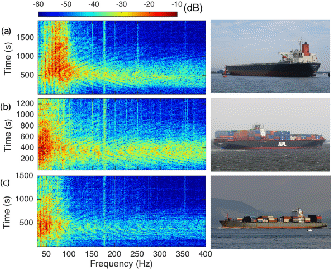As a data-driven source localization method, machine learning begins to draw the attention among ocean acoustic community.
Based on previous research on machine learning for source localization published in the Journal of the Acoustical Society of America (Vol. 142, No.3, September 2017), researcher NIU Haiqiang from the Institute of Acoustics (IOA) of the Chinese Academy of Sciences and his colleagues from USA applied the machine learning classifiers to the ship localization in Santa Barbara Channel off the west coast of California, and demonstrated that machine learning classifiers produce reasonable range estimates at longer ranges, than conventional matched field processing (MFP), with limited environmental information.
The research was also published in the Journal of the Acoustical Society of Acoustics (vol. 142, No. 5, November 2017).
The experiment was conducted in Santa Barbara Channel with water depth 540-600m in 2016. Moreover, three randomly selected transiting ships with varying speed were used as underwater sources.
The hydrophone array consisting of 28 sensors (77 m aperture) recorded noise from ships exiting or entering Los Angeles harbor. Data from three ship tracks during different periods were used to form training and test data sets. The corresponding spectrograms recorded on the top hydrophone are shown in Figure 1.

Figure 1. Spectrograms of shipping noise at the top hydrophone during three periods (Image by NIU Haiqiang).
Researchers investigated two frequency bands (53-200 Hz and 203-350 Hz) and compared range predictions on the two test data sets between using conventional MFP and using machine learning classifiers.
As a result, machine learning classifiers outperformed conventional MFP and were more robust to low signal noise ratio at ranges greater than 4 km.
It is demonstrated that machine learning classifier methods generate reasonable range predictions without knowledge of the ocean environment, even when the data are from different sources with different moving speeds.
The research was supported by the Office of Naval Research, the China scholarship Council, and the National Natural Science Foundation of China.
Reference:
NIU Haiqiang, Emma Ozanich, Peter Gerstoft. Ship Localization in Santa Barbara Channel Using Machine Learning Classifiers. Journal of the Acoustical Society of America Express Letters. (vol. 142, no. 5, pp. EL455-EL460, November 2017). DOI:10.1121/1.5010064.
Contact:
WANG Rongquan
Institute of Acoustics, Chinese Academy of Sciences, 100190 Beijing, China
E-mail: wangrongquan@mail.ioa.ac.cn


